TORONTO, CANADA – Ivanhoe Mines (TSX: IVN) today announced its financial results for the third quarter ended September 30, 2015. All figures are in U.S. dollars unless otherwise stated.
HIGHLIGHTS
- The Kamoa pre-feasibility study (PFS) is expected to be finalized in early 2016. The PFS is based on the project’s planned first phase and is consistent with the phased approach to project development outlined in the 2013 Kamoa preliminary economic assessment. Phase one will see the construction of an underground operation producing three million tonnes a year and feeding an adjacent concentrator. Metallurgical test work has indicated that copper recoveries averaging 86% and concentrate grades averaging 39% copper are achievable.
- Initial shaft sinking activities (drilling, blasting and mucking) at Platreef’s Shaft 1 commenced on October 26, 2015, following successful construction of the shaft collar and ventilation plenum. Shaft 1 will have an internal diameter of 7.25 metres; it is projected to intersect the Flatreef deposit at a depth of 777 metres below surface in late 2017 and reach its total depth of 975 metres in 2018. Selected mining areas in the current Platreef mine plan occur at depths ranging from approximately 700 metres to 1,200 metres below the surface.
- In early August, Ivanhoe Mines began work on a feasibility study that will cover the first phase of mine development at the company’s Platreef Project in South Africa. The study will build upon the findings of the pre-feasibility study completed in January 2015 that included construction of an underground mine, an initial four-million-tonne-per-year concentrator and associated infrastructure to support initial concentrate production by 2019. The pre-feasibility study estimated a planned initial, average annual production rate of 433,000 ounces of platinum, palladium, rhodium and gold (3PE+Au), plus 19 million pounds of nickel and 12 million pounds of copper per year, at an estimated cost of $322 per ounce of 3PE+Au, net of by-products. There will be opportunities to refine and modify the timing and capacities of subsequent phases of production to suit market conditions during the development and commissioning of the first phase.
- The three projects achieved a combined 12.8 million hours of lost-time-injury-free (LTIF) work by the end of Q3 2015, reflecting, in part, the company’s continued efforts to prioritize the management of health and safety on its job sites. Ivanhoe recorded 4.8 million LTIF hours at Platreef, 4.4 million hours at Kamoa and 3.6 million hours at Kipushi by the end of Q3 2015. The Platreef Project subsequently has reported two lost-time injuries.
- At the Kipushi zinc-copper project in the DRC, a total of 2,708 metres in six drill holes were completed in Q3 2015 in the Big Zinc and Nord Riche zones and the southern exploration area. By the end of Q3 2015, a total of 24,035 metres of drilling had been completed in 96 holes since Ivanhoe started its drilling program in March 2014. Ivanhoe completed the exploration drilling program in October 2015. Ivanhoe is working with MSA of Johannesburg to finalize an updated Mineral Resource Estimate for the Kipushi Project that will incorporate all of the drill results received to date. The independent estimate, which is being prepared in accordance with 2014 CIM definition standards, is expected to be completed and issued during Q4 2015. A preliminary economic assessment will be undertaken based on the updated resource estimate.
Principal projects and review of activities
Ivanhoe Mines is advancing and developing its three principal projects in Southern Africa:
- The Kamoa Copper Project, based on development of a planned mine on the company’s copper discovery in a previously unknown extension of the Central African Copperbelt in the Democratic Republic of Congo. In March this year, members of the Ivanhoe Mines exploration team received the prestigious Thayer Lindsley Award from the Prospectors & Developers Association of Canada for the Kamoa copper discovery, recognized as 2014’s top international mineral discovery.
- The Platreef Project, with construction of a planned mine now underway on the company’s discovery of platinum, palladium, nickel, copper, gold and rhodium on the Northern Limb of South Africa’s Bushveld Complex. The South African beneficiaries of a broad-based, black economic empowerment structure have a 26% stake in the Platreef Project and the remaining 10% is owned by a Japanese consortium of ITOCHU Corporation and its affiliate, ITC Platinum Development Ltd.; Japan Oil, Gas and Metals Corporation; and Japan Gas Corporation.
- The Kipushi Project, involving the confirmation and expansion of resources at the historic, high-grade Kipushi zinc, copper and germanium mine, also on the Copperbelt in the DRC, which now are being drilled and upgraded by Ivanhoe following its acquisition of a majority interest in the mine in 2011. Kipushi was operated by previous owners between 1924 and 1993.
1. Kamoa Project
95%-owned by Ivanhoe Mines
Democratic Republic of Congo (DRC)
The Kamoa Project is a very large, stratiform copper deposit with adjacent prospective exploration areas within the Central African Copperbelt, approximately 25 kilometres west of the town of Kolwezi and about 270 kilometres west of Lubumbashi. Ivanhoe has agreed to sell a 49.5% share interest in Kamoa Holding Limited (Kamoa Holding), the Ivanhoe subsidiary that presently owns 95% of the Kamoa Project, to Zijin Mining Group Co., Ltd (Zijin) for an aggregate consideration of $412 million. The purchase price will be satisfied by an initial payment of $206 million in cash upon the closing of the transaction. The agreements specify that the remaining $206 million will be paid in five equal instalments, payable every 3.5 months from closing.
In addition, Ivanhoe has agreed to sell 1% of its share interest in Kamoa Holding to Crystal River Global Limited (Crystal River) for $8.32 million – which Crystal River will pay through a non-interest-bearing, 10-year promissory note.
A 5%, non-dilutable interest in the Kamoa Project was transferred to the DRC government on September 11, 2012, for no consideration, pursuant to the DRC Mining Code. Ivanhoe also has offered to transfer an additional 15% interest to the DRC government on terms to be negotiated.
Kamoa is the world’s largest undeveloped, high-gradecopper deposit. On January 17, 2013, an updated mineral resource estimate was issued that increased Kamoa’s Indicated Mineral Resources to a total of 739 million tonnes grading 2.67% copper and containing 43.5 billion pounds of copper. This was an increase of 115% over the previous estimate, prepared in September 2011, of 348 million tonnes grading 2.64% copper and containing 20.2 billion pounds of copper. Both estimates used a 1.0% copper cut-off grade and a minimum vertical mining thickness of three metres.
In addition to the Indicated Resources, the updated estimate included Inferred Mineral Resources of 227 million tonnes grading 1.96% copper and containing 9.8 billion pounds of copper, also at a 1.0% copper cut-off grade and a minimum vertical mining thickness of three metres.
At a higher, 2.0% copper cut-off grade, Kamoa’s Indicated Resources total an estimated 550 million tonnes grading 3.04% copper and containing 36.9 billion pounds of copper. At the 2.0% cut-off, Kamoa also has 93 million tonnes of Inferred Resources grading 2.64% copper, which contain an estimated 5.4 billion pounds of copper.
Health and safety at Kamoa
Health and safety remain key priorities at the mine site. The Kamoa Project is very proud of the excellent safety record achieved to date. By the end of Q3 2015, 4,396,729 hours had been worked without a lost-time injury.
The Ivanhoe Mines Fionet program was launched during Q3 2015. The first phase of the program will cover two established provincial health zones that provide services to a total of approximately 300,000 residents living in 40 urban centres and 330 villages. The Kipushi Health Zone, in southern Haut-Katanga province, includes Ivanhoe’s Kipushi Mine project. The Kanzenze Health Zone, in Lualaba province, includes Ivanhoe’s Kamoa Project.
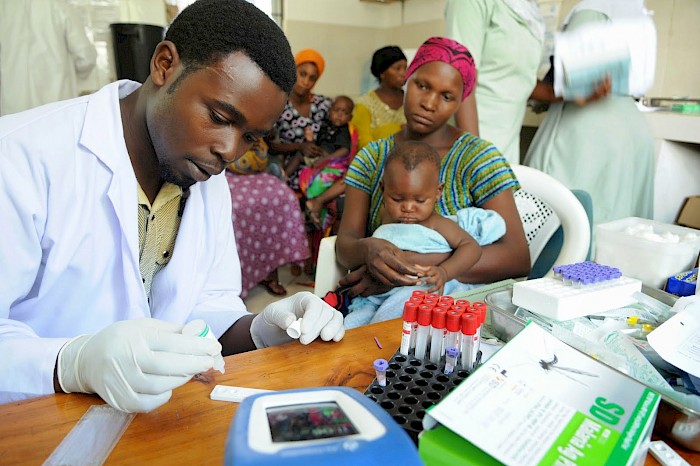
Figure 1: Fio’s Deki Reader introduces a new dimension in malaria detection, helping to deliver a rapid, accurate diagnosis and transmitting results to a cloud database.
The Fionet™ system, developed by Canada-based Fio Corporation, will be introduced into the DRC through the three-year program being sponsored by Ivanhoe Mines. Fionet combines mobile, intelligent devices and cloud data services to help health workers improve the accuracy of diagnostic testing and quality of care that they provide to patients. The Fionet system also improves the quality and usefulness of the accumulated data, which can be accessed to assist with the monitoring of patient care, research and the planning of future prevention and treatment programs. With support from U.S.-based Chemonics International, DRC health workers will use Fionet to strengthen activities under the country’s National Malaria Control Program.
The program utilizes mobile smart devices to rapidly diagnose infectious diseases in rural settings. The initiative is being implemented by Chemonics International, an organization with extensive experience in managing development projects in the DRC and elsewhere in Africa.
Diamond drilling progress
Limited drilling occurred in Q3 2015, with 725 metres completed in five shallow holes. This brought the total metres drilled to 1,719 for the nine months ended September 30, 2015. One hole was completed in Kamoa Nord to test for shallow mineralization close to the Kamoa Dome, three holes were completed in Kansoko Nord to gain confidence in the high grade mineralization up-dip, and one hole was drilled on one of the regional exploration licences to assist with relinquishment decisions.
The newly purchased deep-drilling Dando rig began drilling in Q3 2015 and is expected to continue drilling through the remainder of 2015. Ivanhoe also is considering mobilizing the two company-owned Landcruiser-mounted rigs. The exploration program will focus on completing the assessment of regional exploration targets to the west of Kamoa, then begin an exploration drilling program at Kakula where previously high-grade copper mineralization was intersected. Initial drilling at Kakula is planned at 800-metre centres within the previously intersected high-grade zone, with additional, wider spaced drilling to increase the potential size of the mineralized area.
Preparation for construction of first declines
The construction of the box cut for the first access declines to the initial, planned underground mine was completed at the end of 2014. This will enable the construction of the twin declines that have been designed to intersect the high-grade copper mineralization in the Kansoko Sud area, approximately 150 metres below the surface.
Ivanhoe’s drilling program in this area has defined a thick, near-surface zone of high-grade copper mineralization where a recent hole intercepted 15.7 metres (true width) of 7.04% copper, at a 1.5% total copper cut-off.
Byrnecut Underground Congo SARL (BUCS) was selected as the contractor to carry out the permanent support of the box-cut walls and the initial, 1.2 kilometres of development for each of the two declines. Contract negotiations are complete and a letter of award has been issued to BUCS for the permanent support of the box cut. Work is expected to start early in 2016, expected to be followed by the initial development for each of the two declines. In the meantime, Ivanhoe is conducting repair and modification work on the box-cut berms. A geotechnical evaluation report for decline support design has been completed by SRK; the findings have been incorporated into the design.
A local DRC contractor, Tanga Logistics and Mining SA (TLM), recently completed the civil works in the box cut, including the drains, sump and roadway. Ivanhoe is preparing the box-cut site for the mobilization of the decline contractor, which includes upgrading of existing accommodation, the supply of power, diesel fuel, workshops and offices.
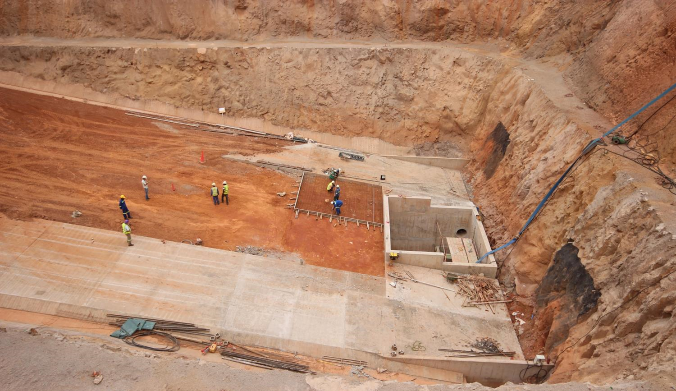
Figure 2: Box-cut civil works in progress on the sump and roadway.
Pre-feasibility study progressing
The Kamoa pre-feasibility study (PFS) is progressing and the completed report is expected to be finalized in early 2016. The PFS is based on the project’s planned first phase and therefore will be consistent with the phased approach to project development outlined in the 2013 Kamoa preliminary economic assessment. Phase one will see the construction of an underground operation producing three million tonnes a year and feeding an adjacent concentrator.
Metallurgical test work has indicated that copper recoveries averaging 86% and concentrate grades averaging 39% copper are achievable.
Continued focus on community and sustainability
During Q3 2015, the construction of the community office for the Muvunda chiefdom was completed and handed over to the community. A local contractor has been appointed and soon will start work on upgrades and extensions to the Mbwetsi school.
Ivanhoe continued with its Livelihood sustainability program. During the quarter, the team focused on vegetable production, establishing new beehives, training village residents on poultry management and harvesting of the 2014/2015 maize (corn) crop. Current community-based activities include the construction of poultry coops in two local villages, the ploughing of maize fields and ongoing training.
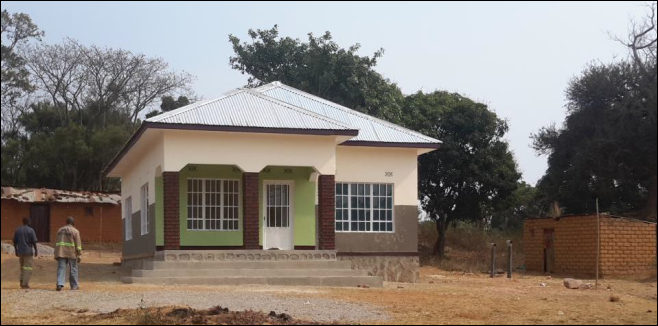
Figure 3: Newly built community office for the Muvunda chiefdom.
A social and environmental management system has been developed to monitor and record environmental and community statistics. The environment team continued with regular monitoring of air quality, ground and surface water and noise during Q3 2015.
Hydroelectric power plant upgrading project
The installation of four new overhead cranes and the repair of turbine number one, under the terms of the pre-financing agreement with SNEL, is progressing well at the Mwadingusha hydroelectric power plant on the Lufira River, near the town of Mwadingusha, approximately 250 kilometres northeast of Kamoa. The repairs are required to secure 10 megawatts (MW) of power for the construction of the Kamoa Project. Electrical connection to the national power grid is underway and expected to be completed in Q4 2015.
Tender documents for the implementation of the construction power line and substation are being finalized.
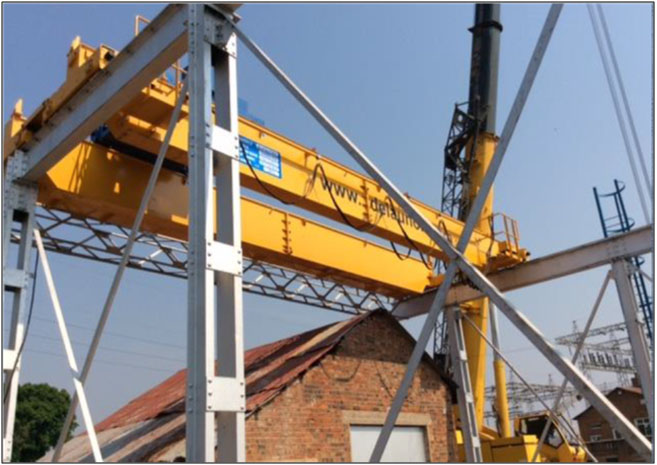
Figure 4: Mechanical installation of four overhead cranes completed at the Mwadingusha hydroelectric plant.
2. Platreef Project
64%-owned by Ivanhoe Mines
South Africa
The Platreef Project in South Africa’s Limpopo province is 64%-owned by Ivanhoe through its subsidiary, Ivanplats (Pty.) Ltd. (Ivanplats), and 10%-owned by a Japanese consortium of ITOCHU Corporation and its affiliate, ITC Platinum; Japan Oil, Gas and Metals National Corporation; and Japan Gas Corporation. The consortium’s interest in the Platreef Project was acquired in two tranches for a total investment of $290 million. The remaining 26% interest is held by Ivanhoe’s broad-based, black economic empowerment (B-BBEE) partners, which include communities, employees and entrepreneurs. Ivanplats announced in February that it had achieved Level 3 status in its first verification assessment on a B-BBEE scorecard, the highest-ranking platinum-sector mining company in compliance with South Africa’s black empowerment laws.
The Platreef Project hosts an underground deposit of thick, platinum-group metals, nickel, copper and gold mineralization in the Northern Limb of the Bushveld Igneous Complex, approximately 280 kilometres northeast of Johannesburg.
On the Northern Limb, such mineralization is hosted primarily within the Platreef, a mineralized sequence that is traced more than 30 kilometres along strike. Ivanhoe’s Platreef Project, within the Platreef’s southern sector, is comprised of three contiguous properties: Turfspruit, Macalacaskop and Rietfontein. Turfspruit, the northernmost property, is contiguous with, and along strike from, Anglo Platinum’s Mogalakwena group of mining operations and properties.
Since 2007, Ivanhoe has focused its exploration activities on defining and advancing the down-dip extension of its original Platreef discovery, now known as the Flatreef Deposit, which is amenable to highly mechanized, underground mining methods. The Flatreef area lies entirely on the Turfspruit and Macalacaskop properties.
Health and safety at Platreef
The Platreef Project achieved more than four years without a lost time injury to the end of Q3 2015, accumulating 4,828,558 Lost-Time-Injury-Free worker hours. However, two unfortunate lost-time injuries occurred in October 2015. The Platreef Project continues to strive toward its workplace objective of an environment that causes zero harm to any employees, contractors, sub-contractors and consultants.
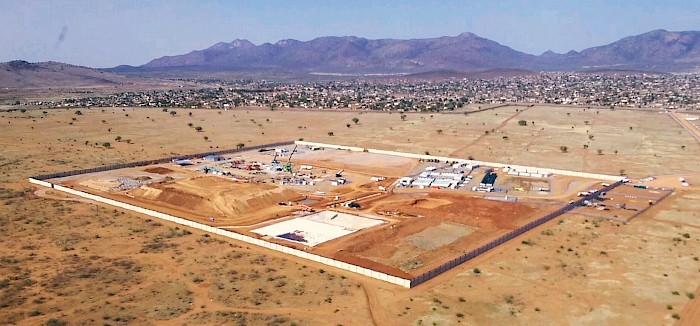
Figure 5: Aerial view of the Platreef Project infrastructure area, October 2015.
Shaft 1 construction
The construction of the large, concrete shaft collar and ventilation intake plenum is complete. Mechanical installations continue on the stage and kibble winders. The pre-sink winder that will be operated during initial sinking down to 60 metres has been commissioned. Initial sinking activities (drilling, blasting and mucking) have begun. Work is complete on the internal electricity substation, which will have a capacity of five million volt amperes (MVA). Construction is underway of the power transmission lines from Eskom, the South African public electricity utility, which will be used for the sinking of Shaft 1. Back-up generators have been installed to ensure continuous sinking operations even if the power supply from Eskom is interrupted.
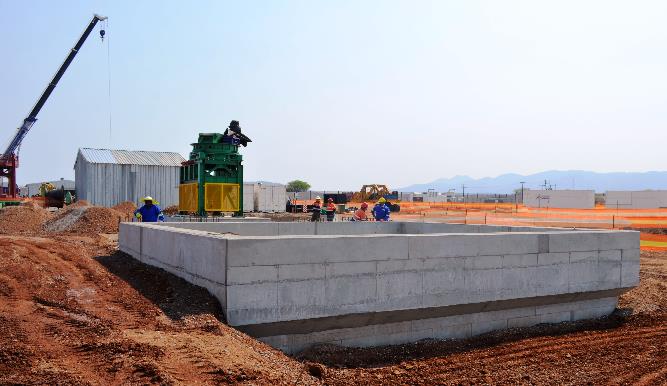
Figure 6: Top of Shaft 1 collar and pre-sink winder installation.
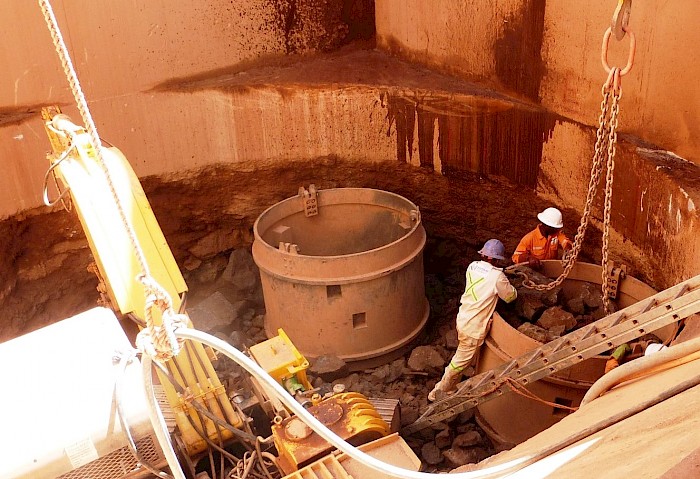
Figure 7: Initial sinking activities at Shaft 1 bottom.
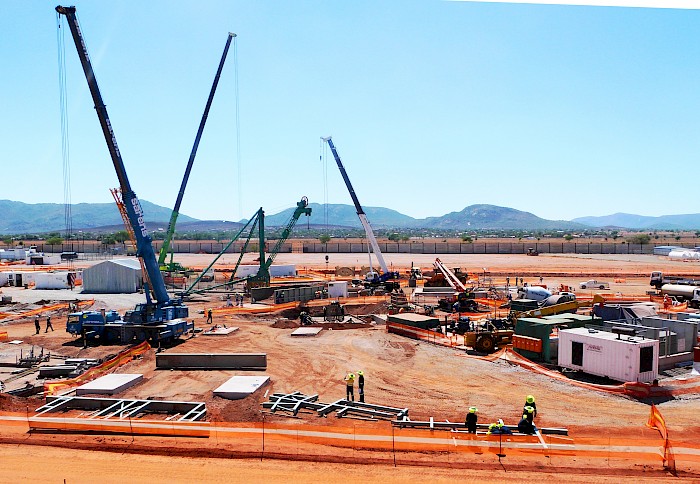
Figure 8: Overall view of Shaft 1 works.
Other on-site work includes the construction of the primary terraces for Shaft 1, storm-water drains and ponds, workshops and stores. A total of 485, or 72%, of the 678 permanent and contract workers presently employed by Ivanplats are from the local area.
Platreef implementing a phased approach to a large, underground, mechanized mine
Ivanplats completed a pre-feasibility study (PFS) in January 2015 that covered the first phase of development that is expected to include construction of an underground mine, concentrator and other associated infrastructure to support initial concentrate production by 2019. There will be opportunities to refine and modify the timing and capacities of subsequent phases of production to suit market conditions during the development and commissioning of the first phase. The feasibility study, based on the first phase, began in August 2015.
PFS highlights
- Development of a large, mechanized, underground mine with an initial four-million-tonne-per-year concentrator and associated infrastructure.
- Planned initial average annual production rate of 433,000 ounces of platinum, palladium, rhodium and gold (3PE+Au), plus 19 million pounds of nickel and 12 million pounds of copper.
- Estimated pre-production capital requirement of approximately $1.2 billion, including $114 million in contingencies, at a ZAR:USD exchange rate of 11 to 1.
- Platreef would rank at the bottom of the cash-cost curve, at an estimated $322 per ounce of 3PE+Au, net of by-products.
- The planned Platreef mine is projected to require a workforce of approximately 2,200 within four years of the start of production.
- After-tax Net Present Value (NPV) of $972 million, at an 8% discount rate.
- After-tax Internal Rate of Return (IRR) of 13%.
The development scenarios describe a staged approach structured to provide opportunities to expand the operation based on demand, smelting and refining capacity and capital availability. As the Phase one production scenario is developed and placed into production, there is expected to be an opportunity to modify and optimize the subsequent phases, allowing for changes to the timing of capacity expansions to suit market conditions.
Mineral resources in the Flatreef underground discovery
The Flatreef Mineral Resource, with a strike length of 6.5 kilometres, lies predominantly within a flat to gently dipping portion of the Platreef mineralized belt at relatively shallow depths of approximately 700 to 1,100 metres below the surface.
The Flatreef Deposit is characterized by its very large vertical thicknesses of high-grade mineralization and a platinum-to-palladium ratio of approximately 1:1, which is significantly higher than other recent PGM discoveries on the Bushveld’s Northern Limb. The grade shells used to constrain mineralization in the Flatreef Indicated Mineral Resource area have average true thicknesses of approximately 24 metres at a cut-off grade of 2.0 grams per tonne (g/t) of platinum, palladium and gold (2PE+Au). The Indicated Mineral Resource grade at an equivalent 2.0-gram-per-tonne 3PE+Au cut-off is 4.1 g/t 3PE+Au, 0.34% nickel and 0.17% copper. Flatreef’s Indicated Mineral Resources of 214 million tonnes contain an estimated 28.5 million ounces of platinum, palladium, gold and rhodium, 1.6 billion pounds of nickel and 0.8 billion pounds of copper. Ivanplats has declared an initial Probable Mineral Reserve of 15.5 million ounces of platinum, palladium, rhodium and gold, using a declining Net Smelter Return (NSR) cut-off of $100/t-$80/t.
Mining methods
The selected mining areas in the current Platreef mine plan occur at depths ranging from approximately 700 metres to 1,200 metres below the surface. The main access to the ore body and ventilation system is expected to be comprised of four vertical shafts. Shaft 2 will host the main personnel transport cage, material and ore-handling systems, while Shafts 1, 3 and 4 will be utilized for ventilation to the underground workings. Shaft 1, now under development, will be used for initial access to the ore body and early underground development.
Mining will be performed using highly productive, mechanized methods, including long-hole stoping, drift-and-bench and drift-and-fill mining methods. The mined out areas within the ore body will be backfilled with a paste mixture that utilizes tailings from the process plant and cement. The ore will be hauled from the stopes to a series of ore passes that connect to a main haulage level, connected to Shaft 2, where it will be crushed and hoisted to surface for further beneficiation.
Metallurgical and processing
Metallurgical test work has focused on maximizing the recovery of platinum-group elements (PGE) and base metals, while producing an acceptably high-grade concentrate suitable for further processing and/or sale to a third party. The three main geo-metallurgical units and composites have produced smelter-grade final concentrates of approximately 85 g/t PGE + Au at acceptable PGE recoveries. Testwork also has shown that the material is amenable to treatment by one stage of mainstream grinding followed by conventional flotation, without the need for concentrate re-grinding. Batch open-circuit and locked-cycle flotation testwork has been performed.
Comminution and flotation testwork has indicated that the optimum grind size is 80% passing 75 µm (micrometres), which is consistent with sizes commonly reported by platinum mines in South Africa. The circuit developed during 2014 and 2015 includes the use of industry-standard reagents and has replaced the previous circuit that included niche flotation reagents.
Platreef ore is classified as ranging from hard to very hard, and thus is not suitable for semi-autogenous grinding. A multi-stage crushing and ball-milling circuit is the preferred option.
A two-phased development approach was used for PFS flow-sheet design. The selected flow sheet is comprised of a four-million-tonne-per-year, three-stage crushing circuit that will feed crushed material to two parallel milling-flotation modules, each with a capacity of two million tonnes per year. Flotation is followed by a four-million-tonne-per-year tailings handling and concentrate thickening, filtration and storage circuit.
Contracts for Shafts 1 and 2
Shaft 1 will have an internal diameter of 7.25 metres; it is projected to intersect the Flatreef deposit at a depth of 777 metres below surface in late 2017 and reach its total depth of 975 metres in 2018. South Africa-based Aveng Mining, the shaft-sinking contractor, also is responsible for the excavation of the box-cut access for the shaft collar and vent plenum. The fabrication of the temporary, sinking head-frame and centre tower was completed during the quarter and delivered to site.
Shaft 2 will have an internal diameter of 10.0 metres and will be capable of hoisting six million tonnes per year. Ivanhoe awarded the contract for the design and engineering of Shaft 2 to South Africa-based Murray & Roberts Cementation in June 2014. Ivanhoe expects to start Shaft 2 early works in 2016, including civil work for the box cut and hitch foundation. Designs for the box cut have been completed and the contract for the early engineering works for the winding equipment has been awarded to South Africa-based FLSmidth.
Bulk water and electricity supply
The Olifants River Water Resource Development Project (ORWRDP) is designed to deliver water to the Eastern and Northern limbs of South Africa’s Bushveld Igneous Complex. The project consists of the new De Hoop Dam, the raised wall of the Flag Boshielo Dam and related pipeline infrastructure that ultimately will deliver water to Pruissen, southeast of the Northern Limb. The Pruissen Pipeline Project will be developed to deliver water onward from Pruissen to the municipalities, communities and mining projects on the Northern Limb. Ivanhoe is a member of the ORWRDP’s Joint Water Forum. The Minister of Water & Sanitation has directed that the Trans-Caledon Tunnel Authority will serve as the implementing agent for the outstanding phases of the ORWRDP scheme, which include the Phase 2B pipeline from Flag Boshielo Dam to Mokopane.
Participants in the water development scheme are required to indicate their water requirements so that the total water demand may be calculated relative to the scheme’s capacity. The Platreef Project’s water requirement for the first phase of development is projected to peak at approximately 10 million litres per day. Ivanhoe also is continuing to investigate various alternative bulk water sources.
The Platreef Project’s power requirement for a four-million-tonne per year underground mine, concentrator and associated infrastructure has been estimated at approximately 100 million volt amperes (MVA). As power is required for the initial mine development work, including shaft sinking, before the main power supply becomes available, an agreement with Eskom has been reached for the supply of 5MVA of temporary construction power.
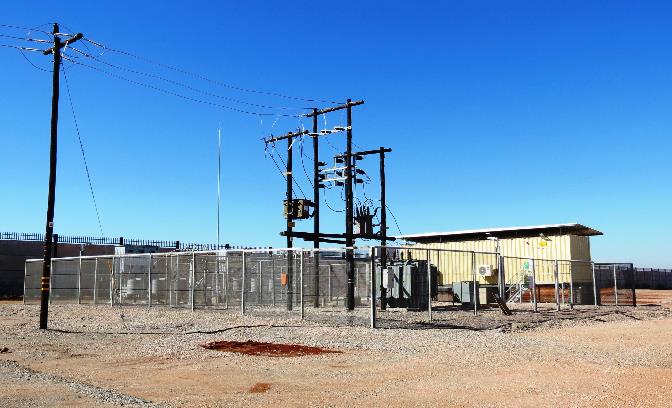
Figure 9: Construction of a 5MVA substation at Platreef is complete.
Exploration and resource expansion drilling
There was no exploration diamond drilling undertaken during Q3 2015. Exploration and resource development activities were focused on completing structural and geological interpretations across the property in preparation for a new resource estimate.
Development of human resource and job skills
Work is progressing well on implementation of Ivanplats’ Social and Labour Plan, to which the company has pledged a total of R160 million ($12 million) during the next five years. The approved plan includes R67.2 million ($5 million) for the development of job skills among local residents and R87.7 million ($7 million) for local economic development projects. A total of 134 employees participated in planned internal training that provided members of the current workforce with opportunities to expand their skills.
Adult Basic Education and Training for the communities has begun in four community centres, following a partnership with the Department of Higher Education and Training. Offices were established for facilitator preparation and class attendance is planned to be boosted by an open day in November 2015.
The first 78 students completed their technical training in July 2015 and 225 students now are conducting similar skills programs planned for completion in November and December 2015.
Ivanhoe offered seven local internships in different disciplines from January 2015 and subsequently received five Mine Qualification Authority (MQA) grants supporting the initiative. Five fully paid bursaries were allocated to local university students.
Ivanhoe has initiated a R24 million ($2 million) partnership between South Africa’s University of Limpopo and Laurentian University in Canada to develop and equip Limpopo’s geology department to improve its curriculum choices for students, conduct research on the Platreef Project and offer post-graduate studies in geology. Ivanhoe will allocate approximately R12 million ($1 million) to the University of Limpopo and R12 million ($1 million) to Laurentian University over the next five years and has committed to renewing the partnership for a further five-year period. The official launch took place in September 2015 and the first students from South Africa are enrolled in M.Sc. studies at Laurentian University.
Local enterprise and supplier development
Ivanhoe embarked on a supplier development initiative with various local businesses following pre-assessments. This resulted in referrals for development and training with various governmental agencies. The company facilitated the start of three local community businesses: a mine-site kiosk, a manufacturer of personal protective equipment and a mine-site laundry business.
Local economic development
The first year local economic development commitments in the Social and Labour Plan are well advanced. Installation of waterless sanitation units at 36 local schools is progressing well. Six schools were furnished with educational infrastructure, which included new science and computer laboratories, vegetable gardens and educational equipment. Planning for a local multi-purpose community centre and the Lesedi Early Childhood Development Centre also is progressing well. Various special projects were completed during 2015, including sanitation units in public open spaces, refurbishing the Lesedi community centre and installing rainwater harvesting units at indigent households. Installation of rainwater units and upgrading of a community water reservoir is progressing well. The reservoir upgrade will provide an additional 261 kilolitres of water capacity for village areas surrounding the Platreef Project.
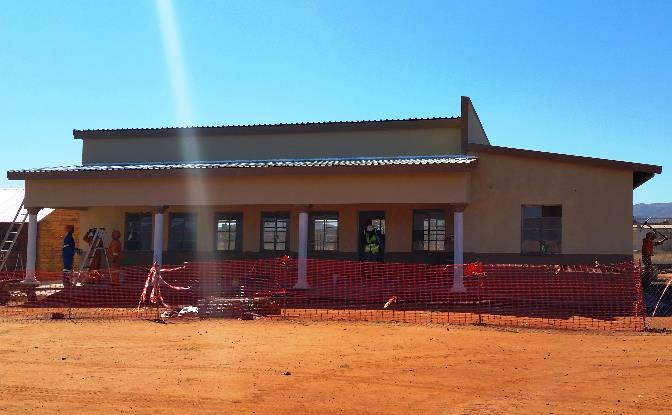
Figure 10: Renovation of a local community care centre.
3. Kipushi Project
68%-owned by Ivanhoe Mines
Democratic Republic of Congo (DRC)
The Kipushi copper-zinc-germanium-lead mine, in the Democratic Republic of Congo, is adjacent to the town of Kipushi and approximately 30 kilometres southwest of Lubumbashi. It also is located on the Central African Copperbelt, southeast of Ivanhoe’s Kamoa Project, and less than one kilometre from the Zambian border. Ivanhoe acquired its 68% interest in the Kipushi Project in November 2011; the balance of 32% is held by the state-owned mining company, La Générale des Carrières et des Mines (Gécamines).
Health and safety at Kipushi
The Kipushi project achieved a total of 3,612,106 lost-time-injury-free hours (1,505 days) to the end of Q3 2015.
Malaria remains the most frequent health concern at Kipushi, with 21 cases reported for Q3 2015. In an effort to reduce the malaria incidence in the Kipushi community, a Water Sanitation and Health (WASH) program has been initiated in cooperation with the Territorial Administrator and the local community. The main emphasis in the program’s first phase is cleaning storm drains in the municipality to prevent the accumulation of ponded water, where malarial mosquitos breed.
The Ivanhoe Mines Fionet Program was rolled-out in the Kipushi Health Zone on August 31, 2015, at the provincial Cinquantenaire Hospital.
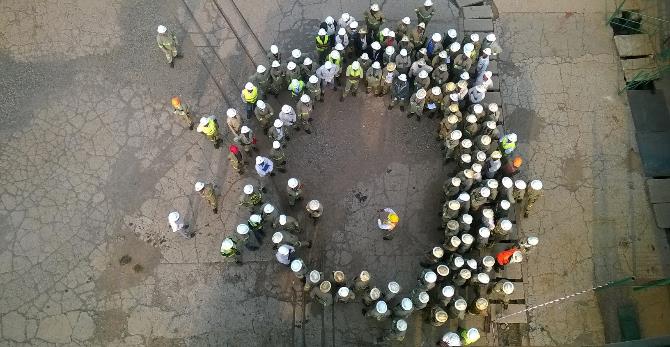
Figure 11: Safety meeting for shaft workers taken from top of Shaft #2 headframe.
Project development and infrastructure
Work began in early March 2014 on the planned underground diamond-drilling program at the Kipushi Project, a major advance made possible by the ongoing dewatering program directed by Ivanhoe during the previous three years following the company’s acquisition of the historic mine in November 2011.
The mine, which had been placed on care and maintenance in 1993, flooded in early 2011 due to a lack of pump maintenance over an extended period. At its peak, water reached 851 metres below the surface level. A major milestone was reached in December 2013 when Ivanhoe restored access to the mine’s principal haulage level at 1,150 metres below the surface.
Since then, crews have been upgrading underground infrastructure to permanently stabilize the water levels and support the drilling program. Recent improvements included refurbishment and commissioning of the friction-reeler gearbox in Shaft 5, secondary emergency exit ladders and platforms completed in shafts P2, P3 and P15, emergency hoist installed in Shaft 3 and safety-cage door interlocks installed in shafts P2, P3 and P5 Maryanne.
Water levels have stabilized below the 1,150-metre-level haulway and the 1,272-metre-level hanging-wall drift, enabling access for drilling that has targeted the Série Récurrente, Fault and Big Zinc zones.
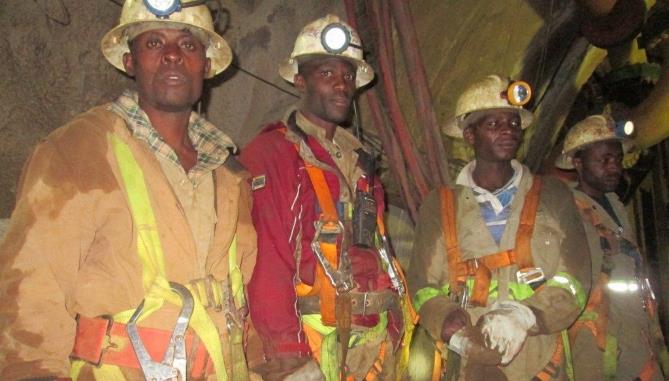
Figure 12: Shaft repair workers replacing guide rails and installing emergency escape ladders and platforms.
Environmental studies and sustainability
Golder Associates was engaged in early 2014 to conduct an International Finance Corporation-compliant Environmental, Social and Health Impact Assessment (ESHIA) baseline study to determine the impact of previous mining activities by Gécamines and provide a baseline for the future. Sampling of mine discharge, ground and surface water and air quality is ongoing to meet regulatory requirements.
Current sustainability programs include the continued maintenance and operation of the potable-water pump station and well field supplying the Kipushi municipality, logistical support to the Kipushi Health Zone and small-animal husbandry programs.
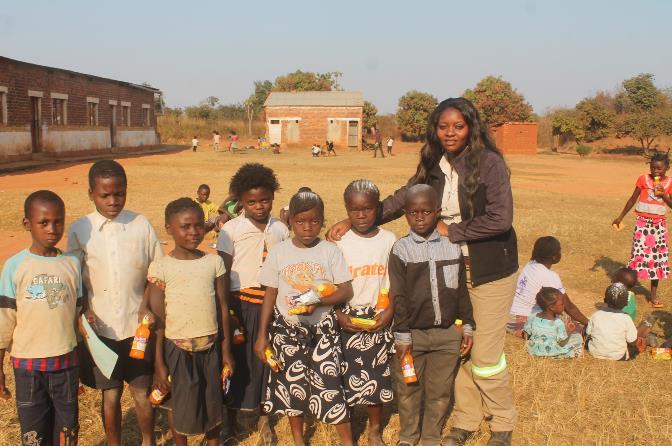
Figure 13: Community relations officer Olivia Simamba with primary school students in Mukoma Village. Ivanhoe supported renovations at the school after severe wind tore off its roof.
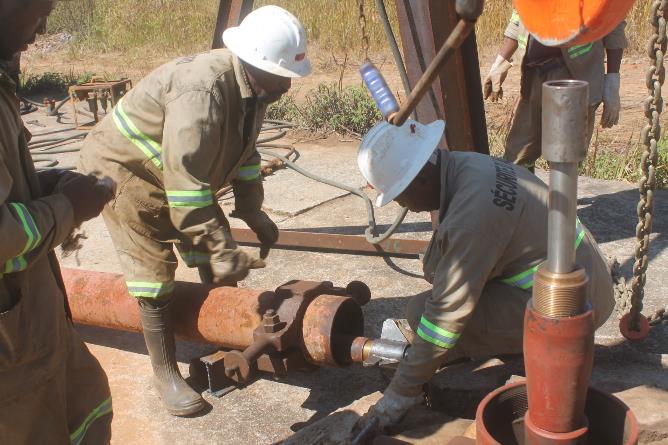
Figure 14: Refurbishment of a borehole pump in the potable water wellfield supplying all of Kipushi municipality.
Confirmatory and exploration drilling
Ivanhoe’s underground drilling program at Kipushi is designed to confirm and update the mine’s estimated historical mineral resources and to further expand the resources along strike and at depth.
As a result of the success of the exploration program, a decision was made in Q3 to again extend the program of follow-up exploration on previously identified, promising holes on the Fault Zone south of the Big Zinc and at depth on the Nord Riche.
A total of 2,708 metres in six drill holes were completed in Q3 2015 in the Big Zinc, Nord Riche zones and the southern exploration area. By the end of Q3 2015, a total of 24,035 metres of drilling had been completed in 96 holes since Ivanhoe started its drilling program in March 2014. Ivanhoe completed the exploration drill program in October 2015.
Ivanhoe is working with MSA of Johannesburg to finalize an updated Mineral Resource Estimate for the Kipushi Project that will incorporate all of the drill results received to date. The independent estimate, which is being prepared in accordance with 2014 CIM definition standards, is expected to be completed and issued during Q4 2015. A Preliminary Economic Assessment will be undertaken based on the updated resource estimate.
Kipushi’s 68 years of production history
Following its start-up in 1924 as the Prince Léopold Mine, available records show that Kipushi produced a total of 6.6 million tonnes of zinc and 4.0 million tonnes of copper – from 60 million tonnes grading 11% zinc and approximately 7% copper – until the suspension of operations in 1993. The mine also produced 278 tonnes of germanium between 1956 and 1978.
In addition to the recorded production of copper, zinc, lead and germanium, Gécamines’ mine-level plans for Kipushi also report the presence of precious metals, specifically silver and rhenium. There is, however, no formal record of the production of precious metals on the property.
SELECTED QUARTERLY financial INFORMATION
The following table summarizes selected financial information for the prior eight quarters. Ivanhoe had no operating revenue in any financial reporting period and did not declare or pay any dividend or distribution in any financial reporting period.
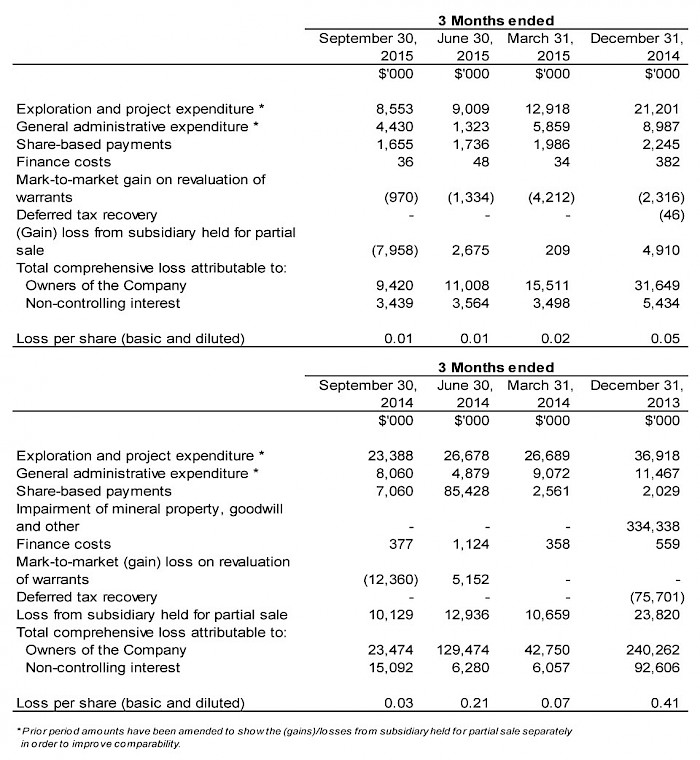
DISCUSSION OF RESULTS OF OPERATIONS
Review of the three months ended September 30, 2015 vs. September 30, 2014
Ivanhoe Mines’ total comprehensive loss for Q3 2015 of $12.9 million was $25.7 million lower than for the same period in 2014 ($38.6 million). The decrease mainly was due to the gain from subsidiary held for partial sale of $8.0 million in Q3 2015 compared to a loss from subsidiary held for partial sale of $10.1 million for the same period in 2014.
On May 26, 2015, Ivanhoe announced that Zijin Mining Group Co., Ltd. had agreed to buy a 49.5% share interest in Kamoa Holding Limited, an Ivanhoe subsidiary that presently owns 95% of the Kamoa Project, for an aggregate consideration of $412 million. In addition, Ivanhoe agreed to sell 1% of its share interest in Kamoa Holding to Crystal River Global Limited for $8.32 million.
Kamoa Holding and its subsidiaries, which include the Kamoa Project, have been classified as a subsidiary held for partial sale in terms of IFRS 5, in anticipation of the sale. Ivanhoe continues to work with all parties to satisfy the conditions to closing of the purchase and sale of the 49.5% interest in Kamoa Holding to Zijin, prior to the agreement’s expiry on November 26, 2015.
The Kamoa Project received $9.1 million from the DRC government relating to an indirect tax refund previously expensed, resulting in a gain in Q3 2015. Exploration expenditure at the Kamoa Project for the three months ended September 30, 2015, amounted to $0.7 million compared to $10.8 million for the same period in 2014. Most of the costs incurred at Kamoa during 2015 have been capitalized as development costs, resulting in the decrease when compared to 2014.
The mark-to-market gain on revaluation of warrants decreased to $1.0 million, compared to $12.4 million in Q3 2014, due to a reduction of the active trading price of these warrants.
Exploration and project expenditures for the three months ending September 30, 2015, were $14.8 million less than for the same period in 2014. With the focus also on development at the Platreef Project during 2015, $8.0 million of the total $8.6 million exploration and project expenditure related to Kipushi, where the drilling program and upgrading of the underground and surface infrastructure continued. Expenditure at the Kipushi Project decreased by $5.1 million compared to the same period in 2014.
Review of the nine months ended September 30, 2015 vs. September 30, 2014
Ivanhoe’s total comprehensive loss for the nine months ended September 30, 2015, of $46.4 million was $176.7 million lower than for the same period in 2014 ($223.1 million). The decrease mainly was due to the share-based payment expense of $88.4 million, recognized in 2014 as a result of the Platreef B-BBEE transaction, as well as the capitalization of development costs in the current period on the Platreef and Kamoa projects of $38.0 million and $23.5 million respectively.
During the nine months ended September 30, 2015, Ivanhoe recognized a gain from subsidiary held for partial sale of $5.1 million, while a loss of $33.7 million was recognized in the same period in 2014. The variance resulted from the $9.1 million indirect tax refund received at the Kamoa Project, as well as the capitalization of development costs in the current period. Exploration drilling and related costs of $0.7 million were expensed during the nine months ended September 30, 2015, on the Kamoa Project, compared to $36.5 million for the same period in 2014, while $23.5 million was capitalized as development costs in 2015 to date.
Exploration and project expenditures for the nine months ending September 30, 2015, were $46.3 million less than for the same period in 2014. With the focus on development at the Kamoa and Platreef projects during 2015, $25.0 million of the total $30.5 million exploration and project expenditure related to Kipushi. A total of $4.1 million related to retrenchment costs incurred in the closure of Ivanhoe’s regional exploration company in the DRC.
Expenditure at the Kipushi Project decreased by $13.2 million compared to the same period in 2014.
Financial positionas atSeptember 30, 2015 vs. December 31, 2014
Ivanhoe’s total assets increased by $35.8 million, from $253.1 million, as at December 31, 2014, to $288.9 million as at September 30, 2015. This mainly was due to the increase in assets of subsidiary held for partial sale of $46.8 million and an increase in property, plant and equipment of $21.9 million.
As at September 30, 2015, Kamoa Holding and its subsidiaries, which include the Kamoa Project, continued to be classified as a subsidiary held for partial sale as Ivanhoe awaits the closure of the transaction with Zijin, after which Ivanhoe will retain 49.5% of Kamoa Holding. As at December 31, 2014, assets of a subsidiary held for sale amounted to $3.0 million that represented the carrying value of Ivanhoe’s Australian subsidiaries sold in Q1 2015, while the assets of a subsidiary held for partial sale of $46.8 million as at September 30, 2015, represents the carrying value of assets of Kamoa Holding and its subsidiaries.
The carrying amount of the group is significantly lower than the anticipated fair value, less costs to sell, and therefore no adjustment was made to the carrying value of the Kamoa assets.
The company utilized $38.0 million of its cash resources in its operations and earned interest income of $1.0 million on cash balances in the nine months ended September 30, 2015. A total of $64.0 million was spent on project development and to acquire other property, plant and equipment. Development costs on the Platreef and Kamoa projects amounted to $38.0 million and $23.5 million respectively.
The company’s total liabilities decreased to $42.4 million as at September 30, 2015, from $50.7 million as at December 31, 2014. This was due to a decrease in trade and other payables of $5.4 million, as well as a $6.5 million decrease in the fair value of the share-purchase-warrant financial liability that arose with the issuance of the purchase warrants in Q2 2014 and had a fair value of $0.4 million at September 30, 2015.
LIQUIDITY AND CAPITAL RESOURCES
The company had $85.4 million in cash and cash equivalents and $55.3 million in short-term deposits as at September 30, 2015. Certain of the company’s cash and cash equivalents and short-term deposits, having an aggregate value of $72.5 million, are subject to contractual restrictions as to their use and are reserved for the Platreef Project.
As at September 30, 2015, the company had consolidated working capital of approximately $185.4 million, compared to $162.1 million at December 31, 2014. The Platreef Project working capital is restricted and amounted to $65.6 million at September 30, 2015, and $104.3 million at December 31, 2014. Excluding the Platreef Project working capital, the resultant working capital was $119.8 million at September 30, 2015, and $57.8 million at December 31, 2014. The company believes it has sufficient resources to cover its short-term cash requirements. However, the company’s access to financing always is uncertain and there can be no assurance that additional funding will be available to the company in the near future.
On May 26, 2015, the company signed agreements with Zijin to buy a 49.5% share interest in Kamoa Holding, an Ivanhoe subsidiary that presently owns 95% of the Kamoa Project, for an aggregate consideration of US$412 million. The purchase price will be satisfied by an initial payment of US$206 million in cash upon the closing of the transaction. The agreements specify that the remaining US$206 million will be paid in five equal instalments, payable every 3.5 months from closing. The remaining payments are secured.
The company’s main objectives for the remainder of 2015 and early 2016 at the Kamoa Project remain the finalization of the phase one pre-feasibility study; commencement of the phase one feasibility study; the continuation of drilling and starting construction of the twin declines at Kamoa. At Platreef, priorities are the continuation of the phase one feasibility study, as well as the commencement of Shaft 2 early works, subject to funding. At the Kipushi Project, the principal objective is the completion of a current mineral resource statement and a preliminary economic analysis.
This release should be read in conjunction with Ivanhoe Mines’ unaudited, condensed, consolidated interim financial statements for the three and nine months ended September 30, 2015, and Management’s Discussion and Analysis report available at www.ivanhoemines.com and at www.sedar.com.
Qualified Person
Disclosures of a scientific or technical nature in this news release have been reviewed and approved by Stephen Torr, who is considered, by virtue of his education, experience and professional association, a Qualified Person under the terms of National Instrument 43-101. Ivanhoe Mines has prepared a NI 43-101-compliant technical report for each of the Kamoa Project, the Platreef Project and the Kipushi Project, which are available at www.sedar.com. These technical reports include relevant information regarding the effective date and the assumptions, parameters and methods of the mineral resource estimates on the Kamoa Project and Platreef Project cited in this news release, as well as information regarding data verification, exploration procedures and other matters relevant to the scientific and technical disclosure contained in this news release in respect of the Kamoa, Platreef and Kipushi projects.
Information contacts
Investors
Bill Trenaman +1.604.331.9834
Media
North America: Bob Williamson +1.604.512.4856
South Africa: Jeremy Michaels +27.11.088.4300
Website www.ivanhoemines.com
Cautionary statement on forward-looking information
Certain statements in this release constitute “forward-looking statements” or “forward-looking information” within the meaning of applicable securities laws, including without limitation, the timing and results of: (i) a pre-feasibility study (PFS) at the Kamoa Project in early 2016; (ii) statements regarding the date that construction of the first set of Kamoa twin declines is expected to commence; (iii) statements regarding the declines having been designed to intersect the high-grade copper mineralization in the Kansoko Sud area; (iv) statements regarding further drilling at Kakula; (v) statements regarding the construction of a concrete roadway, drains and de-watering sumps in the Kamoa Project box cut; (vi) statements regarding the projected depth of Shaft 1 at the Platreef Project in 2018 and the timing of the commencement of Shaft 2 development; (vii) statements regarding the operational and technical capacity of Shaft 1; (viii) statements regarding the internal diameter and hoisting capacity of Shaft 2 (ix) statements regarding peak water use of 10 million litres per day at the Platreef Project and development of the Pruissen Pipeline Project; (x) statements regarding the completion of a new resource estimate at the Platreef Project in 2015; (xi) efforts to upgrade historical resource estimates at the Kipushi Project; (xii) the de-watering program at the Kipushi Project; (xiii) statements regarding the completion of the Kipushi Project Environmental, Social and Health Impact Assessment (ESHIA) baseline study and (xiv) statements regarding the timing, size and objectives for completion of drilling and other exploration programs for 2015 and future periods; (xv) statements regarding the completion of installation and repair works at the Mwadingusha power plant in Q4 2015.
Such statements involve known and unknown risks, uncertainties and other factors that may cause the actual results, performance or achievements of the company, or industry results, to be materially different from any future results, performance or achievements expressed or implied by such forward-looking statements or information. Such statements can be identified by the use of words such as “may”, “would”, “could”, “will”, “intend”, “expect”, “believe”, “plan”, “anticipate”, “estimate”, “scheduled”, “forecast”, “predict” and other similar terminology, or state that certain actions, events or results “may”, “could”, “would”, “might” or “will” be taken, occur or be achieved. These statements reflect the company’s current expectations regarding future events, performance and results and speak only as of the date of this release.
As well, the results of the preliminary economic assessment of the Kamoa Project and the pre-feasibility study of the Platreef Project constitute forward-looking information, and include future estimates of internal rates of return, net present value, future production, estimates of cash cost, proposed mining plans and methods, mine life estimates, cash flow forecasts, metal recoveries, and estimates of capital and operating costs. Furthermore, with respect to this specific forward-looking information concerning the development of the Kamoa and Platreef Projects, the company has based its assumptions and analysis on certain factors that are inherently uncertain. Uncertainties include: (i) the adequacy of infrastructure; (ii) geological characteristics; (iii) metallurgical characteristics of the mineralization; (iv) the ability to develop adequate processing capacity; (v) the price of copper, nickel, platinum, palladium, rhodium and gold; (vi) the availability of equipment and facilities necessary to complete development; (vii) the cost of consumables and mining and processing equipment; (viii) unforeseen technological and engineering problems; (ix) accidents or acts of sabotage or terrorism; (x) currency fluctuations; (xi) changes in regulations; (xii) the availability and productivity of skilled labour; (xiii) the regulation of the mining industry by various governmental agencies; and (xiv) political factors.
This release also contains references to estimates of Mineral Resources. The estimation of Mineral Resources is inherently uncertain and involves subjective judgments about many relevant factors. Mineral Resources that are not Mineral Reserves do not have demonstrated economic viability. The accuracy of any such estimates is a function of the quantity and quality of available data, and of the assumptions made and judgments used in engineering and geological interpretation (including estimated future production from the company’s projects, the anticipated tonnages and grades that will be mined and the estimated level of recovery that will be realized), which may prove to be unreliable and depend, to a certain extent, upon the analysis of drilling results and statistical inferences that ultimately may prove to be inaccurate. Mineral Resource estimates may have to be re-estimated based on: (i) fluctuations in copper, nickel, platinum group elements (PGE), gold or other mineral prices; (ii) results of drilling; (iii) metallurgical testing and other studies; (iv) proposed mining operations, including dilution; (v) the evaluation of mine plans subsequent to the date of any estimates; and (vi) the possible failure to receive required permits, approvals and licenses.
Forward-looking statements involve significant risks and uncertainties, should not be read as guarantees of future performance or results and will not necessarily be accurate indicators of whether or not such results will be achieved. A number of factors could cause actual results to differ materially from the results discussed in the forward-looking statements, including, but not limited to, the factors discussed below and under “Risk Factors”, as well as unexpected changes in laws, rules or regulations, or their enforcement by applicable authorities; the failure of parties to contracts with the company to perform as agreed; social or labour unrest; changes in commodity prices; and the failure of exploration programs or studies to deliver anticipated results or results that would justify and support continued exploration, studies, development or operations.
Although the forward-looking statements contained in this release are based upon what management of the company believes are reasonable assumptions, the Company cannot assure investors that actual results will be consistent with these forward-looking statements. These forward-looking statements are made as of the date of this release and are expressly qualified in their entirety by this cautionary statement. Subject to applicable securities laws, the Company does not assume any obligation to update or revise the forward-looking statements contained herein to reflect events or circumstances occurring after the date of this release.
The company’s actual results could differ materially from those anticipated in these forward-looking statements as a result of the factors set forth in the “Risk Factors” section in the company’s Q3 MD&A.


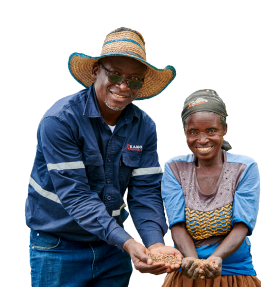
 English
English Français
Français 日本語
日本語 中文
中文